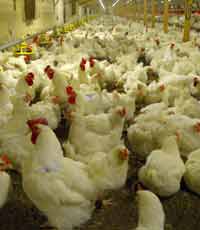Flies: Practical tips to keep them down this summer

to go on site 25 july
category: fra
poultry channel lead
Region: uk
topic: poultry
Pic: any indoor poultry shot
This July saw the first substantial heat wave for several years and this warmer weather brings a heightened risk of fly infestations.
But not only do flies risk complaints from local residents followed by enforcement action from your local authority, but they also spread over 100 different pathogens, such as salmonella.
Therefore fly control is essential, especially during the summer months, and is achievable through a simple integrated control program focusing on both adults and larvae.
Kai Sievert of Novartis Animal Health talks exclusively to Poultry World offering practical tips on how to keep this buzzing menace to a minimum.
Q. Do poultry producers fully understand the importance of fly control?
Some farmers continue to see flies as a natural part of everyday farm life and a problem that will never disappear. To a certain extent they are right – but it is a problem that can be controlled. We have known about flies, from a scientific perspective, for well over 100 years. Attitudes have changed in that time but still have some way to go.
Flies must be regarded as dirty insects that carry disease and, therefore, must be controlled. Disease costs farmers dearly throughout the world and production losses are estimated to be in the millions of pounds.
Q. What are the common diseases spread by flies?
A. The types of disease include viruses such as avian flu, parasites like tapeworm and enteric diseases including E coli and salmonella, especially relevant for poultry producers.
A vertical transmission of salmonella (from larvae via pupae to adults) would represent an additional reservoir and source of re-infection and research into this transmission is currently being carried out.
Q. What is the lifecycle of a common fly?
A. Take the house fly for example – the cycle, from egg, through larva and pupa stages, to adult fly, takes up to three weeks, depending on temperature. There can be anything from 10 to 30 generations (tropics) per year depending on the region and weather.
Flies normally have a short life of two weeks, but can live up to 100 days in the cooler conditions of autumn and winter. This means that if a producer was to take two months to remove an old flock, thoroughly clean out the site and place new birds, those same flies, carrying the same disease, could still be present.
Adult flies only represent 20% of the fly burden and so complete control cannot be achieved by only controlling the adult fly – particular focus must be on the egg, larva and pupa stages too.
Q. How do flies act as vectors of disease?
A. Bacteria, viruses, protozoa and even worm eggs are passed on in a number of different ways – they are eaten by the fly and are therefore in the gut. Even without any sort of ingestion the bugs still stick to the outer hairs and feet of the fly. The fly then simply lands on another animal, or on the animal’s feed, to transfer the pathogen.
Q. You have been very keen to stress a combined approach to fly control – why?
A. An integrated programme is the only way to control flies. Producers should be removing feeding and breeding sites, removing and treating manure using a larvicide, and in addition also using an adulticide. Using one fly control product alone is normally not enough.
Larvicides affect the shell, or skin, of the larva and prevent the growth of new skin, while an adulticide attacks the central nervous system of the fly.
